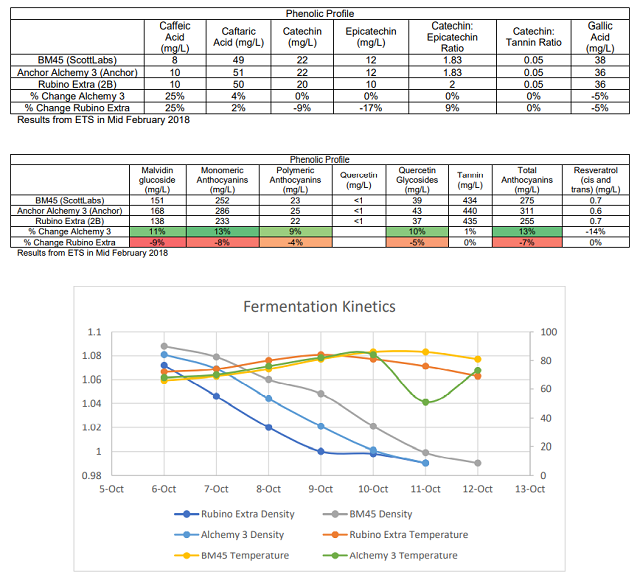Using Yeast to Improve Color and Aroma Extraction from Skins (in Collaboration with 2B) (2017)
Tim Gorman
Cardinal Point Vineyards
Summary
This study examines the impact of Rubino Extra (2B), BM45 (ScottLabs), and Alchemy III (Anchor) on the phenolic and aroma characteristics of Cabernet Franc wines. The goal was to see if the Rubino Extra yeast could enhance anthocyanin and aroma extraction from the grapes, relative to other yeast strains. Grapes were harvested on the same day and processed into 3 separate T Bins. Each of the three T Bins were inoculated with one of the three yeasts. All other treatments between wines were identical. The BM45 trial fermented slowest, and Rubino Extra trial fermented fastest. Lactic acid was higher in the wine produced with BM45. Color intensity varied among yeasts. Anthocyanins were higher in the Alchemy 3 trial, and lower in the Rubino Extra trial. Overall, not many trends were seen between these wines. The Rubino Extra yeast tended to produce wines with slightly lower Overall Aromatic Intensity and Fruit Intensity. The Alchemy 3 and BM45 yeasts were fairly similar, except that BM45 was perhaps more in-between the Rubino Extra and the Alchemy 3 yeast. The Alchemy 3 yeast appeared to produce a distinctive floral or fruity quality. Preference trends reversed between tastings, and as such it is unclear which yeast strain was the most preferred.
Results and Discussion
The BM45 trial fermented slowest, and Rubino Extra trial fermented fastest. This may have been because the Rubino Extra trial seemed to warm up faster. The Rubino yeast is also produced without emulsifiers, reducing the need for a hydration period for the yeast. This may have allowed for a more instantaneous start to the fermentation. Lactic acid was higher in the wine produced with BM45. Color intensity varied among yeasts. Anthocyanins were higher in the Alchemy 3 trial, and lower in the Rubino Extra trial.


For the descriptive analysis on February 28, there was a strong trend for the BM45 wine to have higher Astringency than the Rubino Extra wine (LSD=0.41). The Rubino wine tended to have slightly lower Astringency overall. Body and Overall Aromatic Intensity were slightly lower in the Rubino Extra wine. Fruit Intensity was slightly higher in the Alchemy 3 wine, and Bitterness was slightly lower in this wine. The general preferences for these wines seemed to be for BM45, then Alchemy 3, then Rubino Extra.

For the descriptive analysis on April 18, there were no strong trends for the descriptors used in this study. There was a slight tendency for the Rubino Extra wine to have higher Astringency and lower Overall Aromatic Intensity and Fruit Intensity. The Rubino Extra and the Alchemy 3 wines had a slight tendency for higher Bitterness as well. There was generally a lack of preference for the BM45 wine, whereas the other two were more preferred.

Overall, not many trends were seen between these wines. The Rubino Extra yeast tended to produce wines with slightly lower Overall Aromatic Intensity and Fruit Intensity. The Alchemy 3 and BM45 yeasts were fairly similar, except that BM45 was perhaps more in-between the Rubino Extra and the Alchemy 3 yeast. The Alchemy 3 yeast appeared to produce a distinctive floral or fruity quality. Preference trends reversed between tastings, and as such it is unclear which yeast strain was the most preferred.
Methods
Cabernet Franc grapes from one block (Clay Hill Vineyard) were harvested on October 4, 2017 and split into three T bins. Each bin received 1800 pounds of fruit. 110g/ton AEB Fermotan, 10ppm sulfur dioxide, and 66mg/ton of Color Pro were added to each bin. At this point, the bins were inoculated with the following yeasts:
- Rubino Extra (2B) at 30g/hL
- BM45 (ScottLabs) at 30g/hL
- Alchemy 3 (Anchor) at 30g/hL
On October 5, all bins were chaptalized with 9kg/bin sugar in the morning, and in the afternoon each bin received 12g/hL DAP and 10g/hL Anchor Ferm. Each fermentation received two punchdowns per day. On October 7, another 12g/hL DAP and 10g/hL Anchor Ferm were added into the Rubino fermentation, the same addition was made to the Alchemy fermentation on October 8, and the same addition was made on the BM45 addition on October 9. This staggering was due to the difference in lag phase of these fermentations. On October 11, each bin was coinoculated with MBR Alpha. On October 16, both wines were drained and pressed into barrels (free run only) (2012 Canton Grand Crus).
This trial was tasted on February 28 and on April 18. In order to balance the data set to perform statistical analysis for descriptive analysis on the February 28 tasting, any judge who had not fully completed the descriptive analysis ratings were removed. In order to then make the number of judges between groups equivalent, one judge from groups 2 and 3 was eliminated. This resulted in a final data set of 3 groups, each with 8 judges (considered as replications within groups, and groups were considered as assessors). Data was analyzed using Panel Check V1.4.2. Because this is not a truly statistical set-up, any results which are found to be statistically significant (p<0.05) will be denoted as a “strong trend” or a “strong tendency,” as opposed to general trends or tendencies. The statistical significance here will ignore any other significant effects or interactions which may confound the results (such as a statistically significant interaction of Judge x Wine confounding a significant result from Wine alone). The descriptors used in this study were Fruit Intensity, Herbaceous/Green, Overall Aromatic Intensity, Bitterness, Astringency, and Body.
The same procedures for data analysis were used on the April 18 tasting. For the descriptive analysis in this tasting, one judge was eliminated from group one and one was transferred from group 2 to group 3 so that each group had three judges, for a total of 9 judges.
